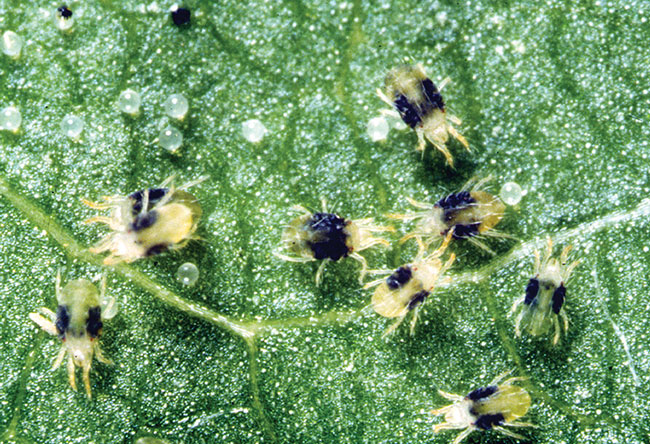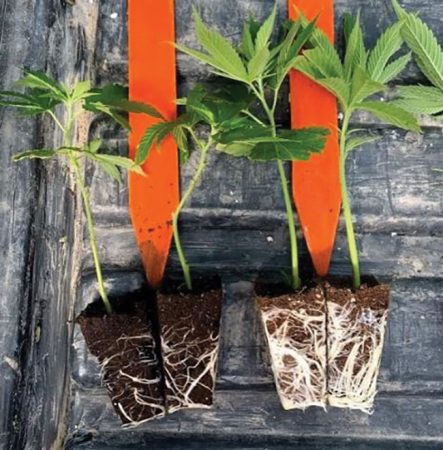
Features
Cultivation
Pest control 101
Taking on pests and diseases through the vegetative phase to flowering and harvest
July 30, 2021 By Michael Brownbridge
 Two-spotted spider mites
Photo: Courtesy of CSIRO
Two-spotted spider mites
Photo: Courtesy of CSIRO The successful growth of a healthy crop through the vegetative and flowering phases is not easy.
It’s heavily determined by the actions taken in propagation, or ‘prop’. Clean stock plants provide a significantly better starting point for production. However, it doesn’t stop there. Early implementation of preventative measures are key to preventing pests and diseases in cannabis crop.
Vegetative to early flowering
Root diseases
Managing root diseases is crucial for any greenhouse crop. Cannabis is no exception, as it’s known to host common soil-borne diseases, like pythium and fusarium.
These diseases are readily transferred in irrigation water, soil, on people, and can easily come via infected clones. Fusarium is known to readily infect stressed plants. Good sanitation practices to reduce inoculum levels on hard surfaces and in prop media, and regular water irrigation tests help ensure it is disease-free.
Biofungicides, introduced in prop and re-applied on a regular basis through the crop cycle, are integral in an integrated plant health management program. Maintaining high populations of beneficial microbes like trichoderma in the growing medium allows for efficient colonization and growth on developing plant roots, protecting them from soil pathogens.
These biocontrol fungi are known to stimulate root growth and improve bioavailability of nutrients in the soil, thereby promoting plant growth and health. In trials, trichoderma applied at sticking resulted in improved root development in clones, translating to about a four per cent increase in flower yield at harvest.
Foliar diseases: Powdery mildew
Cultural practices like pruning and good air circulation help keep powdery mildew in check but the disease inevitably shows up. Regular crop scouting allows early signs of infection to be detected and for treatments to be applied to contain the disease.
Potassium bicarbonate products can be used in a preventative or curative manner. K-bicarbonate brings a physical mode of action to bear and will desiccate mildew spores, destroy cell membranes and, by altering the pH at the leaf’s surface, create conditions that impede powdery mildew growth. The adjuvants in the formulation can be harsh on soft-bodied biocontrol agents but will not harm predators in sachets. Furthermore, once spray residues are dry, they are harmless to beneficials.
Bio-friendly agents in the form of liquid concentrates can help induce natural resistance responses in the plants to protect themselves against infection by powdery mildew. An ideal option closer to harvest, these agents also come as spray oils.
Pest management
Pests such as various mites, root aphids, foliar aphids, and thrips, threaten cannabis in all stages of production. A combination of biopesticides and natural enemies will provide control of these pests. Strategies started during prop to treat and/or suppress pest populations should be continued. Certain practices change during a plant’s lifecycle, but if measures are taken in young plants, it’s likely that pest issues will be limited later in the production cycle.
While it may be tempting to reduce inputs when pests seem to be ‘under control,’ crops can experience resurgences in two-spot and broad mites, thrips and foliar aphids when predator releases were reduced in the later growth stages. Major remediation efforts with biopesticide sprays were then required, and significant crop losses incurred.
Mites
Three species of mites are problematic in cannabis – hemp russet mite, broad mite, and two-spotted spider mite (TSSM). Populations of all three species can rapidly increase because they are hard to detect and the first sign of an infestation may be symptoms of damage. By then, it may be too late to effect control.
Acting early is crucial. Treating clones with biopesticides to provide a relatively quick knock down, followed by early introduction of biological control agents.
Horticultural spray oils will control several problem pests including mites, thrips, aphids and whiteflies. Currently, two oil-based products are approved for cannabis use, but their formulations impart slightly different performance characteristics to each product.
Application rates (one to two per cent) are similar for both products, which should be re-applied every seven to 14 days. Use caution when applying to newly stuck cuttings. At this stage, it is recommended to use the one per cent rate and ideally, wait until plants have developed roots before spraying (approx. seven to 10 days after sticking). Use of spray oils will leave a sheen on the leaves, but does not interfere with transpiration.
Predatory mites include: Amblyseius andersoni, which is moderately effective against hemp russet mite; Neoseiulus cucumeris (also known as Amblyseius cucumeris), a highly efficacious choice for broad mite; and Amblyseius fallacis (also Neoseiulus fallacis) for TSSM in the early stages of production. Phytoseiulus persimilis is an excellent choice for TSSM as plants get older and is effective when introduced to hot spots.
Scouting is an important part of the program to ensure TSSM are detected before the webbing appears. Although oils may kill some predatory mites and other beneficials on contact, they leave no toxic residues when dry and will not harm mites in sachets.
Aphids
Rice root aphid requires immediate attention. Otherwise, it quickly gets out of hand.
Control starts in prop, drenching rooting blocks with an approved Beauveria bassiana formulation, and should continue on a regular basis through production. Cubes and growing media must be thoroughly drenched so that infective Beauveria spores permeate the entire medium and contact aphids on the roots. Later in production, root drenches should be accompanied by foliar sprays to target winged adult aphids. Targeting both life stages typically delivers greater overall efficacy.
Foliar aphids present challenges as plants enter the vegetative phase. Different aphid parasitoids are recommended for different aphid species, and correct aphid identification is necessary to select the best parasitoid for release. Notable foliar aphid pests include those categorized as ‘small’ species, and ‘large’ aphid species (cannabis aphid).
Aphidius colemani or A. matricariae are the best options for ‘small’ aphids; A. ervi for large aphid species. Predators are less discriminating, and Aphidoletes and Chrysoperla (lacewings) eat everything and as such, they often do an excellent job of cleaning up infestations. However, Aphidoletes will not establish under artificial lights. Orius will feed on aphids as well, and when established will help keep several other pests in check.
Biopesticide options include horticultural oils and insecticidal soaps. All are contact insecticides so achieving good spray coverage is critical to efficacy.
Thrips
Western flower thrips can cause a lot of damage in cannabis and often accompany cuttings. Currently, two fungal biopesticides are registered for foliar sprays.
Predator options include N. cucumeris and A. swirskii in sachets on sticks preferred in prop, sachets hung in the canopy as plants get larger. These species primarily feed on first instar thrips on the foliage. Soil-dwelling predators, like Stratiolaelaps scimitus and Dalotia coriaria, feed on pupating thrips. These soil-dwelling predators are first released in prop.
A second release at potting up will ensure they remain for the full crop cycle. These predators can control other pests including broad mites and fungus gnat larvae.
Additional to the natural enemy arsenal in the vegetative stage is the generalist predator Orius insidiosus. If released in hot spots, it can become established for an extended period from the first treatment or release. However, it’s unlikely to persist for several generations in indoor grow facilities under artificial lights and is prone to diapause during the shorter daylight months.
Last, the nematode Steinernema feltiae is a useful addition if needed, applied as a drench to the rooting cubes and then media every two weeks to control fungus gnat larvae and pupating thrips.

RootShield PLUS+ in propagation improves root development in cannabis cuttings, leading to increased yield. Clones on the right were treated with a RootShield PLUS+ drench immediately after sticking into rooting cubes.
Flowering to harvest
The final three weeks of production can be a nail-biting period. Given the sensitivity of the trichomes and the need to consider microbial ‘loadings’ in flowers, few pest and disease management options are available.
To avoid over-loading the flowers with microorganisms, it’s recommended that microbial and potassium bicarbonate sprays shouldn’t be used within three weeks of harvest, to avoid damage to the trichomes.
Oil sprays (at the one per cent rate) can generally be continued up to one week prior to harvest but different cannabis varieties show varying sensitivities. Watch for evidence of phytotoxicity and test first on a small batch. Sprays with non-microbial products can be adjusted based on the results. Biological control agents can be used but if earlier measures have been taken and maintained, pest numbers should remain low through the final three weeks.
One of the biggest challenges at flowering, is Botrytis. With the recent Health Canada decision to allow sprayable nutrients to be applied in cannabis, use of such materials can help promote plant health. Use of sprayable nutrients can enhance uptake of key elements like calcium, which is an essential component of plant cell walls.
Currently, there are a few sprayable materials that can help suppress Botrytis. When choosing sprayable options, be aware of which sprays should be applied during specific stages of the crop lifecycle. All may be rotated within the same program to bring different modes of action to bear. In all cases, try to spray on days when plants will dry within one to two hours, as extra moisture can increase the likelihood of mold development.
Foliar sprays of hydrogen peroxide may be one of the most valuable tools at this time. Peroxide can be integrated into a preventative phytosanitation strategy through the vegetative growth phase and may be continued for the last two weeks through flowering to harvest. The peroxide helps to reduce microbial contamination on the flowers and suppress pathogens. The same precautions apply, in terms of ensuring there are no phytotoxicity risks at the recommended spray rate, and that spray deposits dry within one to two hours.
Some take-homes
No two locations are the same, so it’s impossible to provide a single plant management blueprint to be applied everywhere. The information shared in this article has considered many, but not all of the common challenges and some possible solutions to help during the production cycle.
These strategies have a long history of successful use in other crop settings, and many show similar efficacy in cannabis. This is an evolving area that will see a range of new products and techniques emerge. Check for new registrations and approvals and do not only think about how to manage pests and diseases, but also why they are there. Good sanitation practices and plant nutrition are fundamental to crop health. Creating a successful program requires planning and good record-keeping. You can learn from previous crop: when pests/diseases appeared, what worked, what didn’t and why. Knowledge is power and will help grow the best crop possible.
Michael Brownbridge, PhD is a biological program manager at BioWorks Inc. He can be reached at mbrownbridge@bioworksinc.com
Print this page